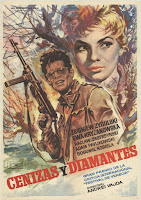1958 was a year that kicked of decades of exploration and wonder. Russia's SPUTNIK was joined in space by the US's first orbiting satellite, The Explorer 1. Later that year, Congress approved funding to form a civilian agency responsible for coordinating America's activities in space called the National Aeronautics & Space Administration (NASA). Cinema did not remain unchanged. The drive to explore the heavens coupled with our nation's willingness to fund said explorations (albeit our motivations were anything but purely scientific), inspired amazing works of scientific based fiction for decades to come. You can find examples of this inspiration from Kubrick's 2001: A SPACE ODDYSEY ('68) to Ridley Scott's THE MARTIAN ('15) and a whole lot of STAR WARS & "Star Trek" in between.
 |
| In a deleted scene, the Xenomorph kept stealing Predator's stapler. |
Another significant advancement in the world of technological wonder happened in 1958. The microchip (or integrated circuit) was created. The concept of miniaturizing multiple transistor circuits gave way to an entirely new direction of progress in the electronics manufacturing industry. This is the technology that would ultimately lead to the fact that you may be reading this on a device that fits into your pocket and has far more computing power than the first space shuttle.
These types of technological advances can be found in all aspects of our lives; not the least of which is the film industry. Smaller, light-weight, cheaper cameras have found their way from low-budget independent flicks to every Summer blockbuster. The camera's lower weight and profile make them much more versatile when it comes to mounting and placement for a far wider range of perspectives. The result of which can be seen in all of its magnificent glory in action films like Gareth Evan's RAID series...
 |
| RAID 2: BERANDAL (2014) |
as well as anything by South Korea's Kim Jee-woon...
 |
| I SAW THE DEVIL (2010) |
Aside from the portability of the equipment, its continuously dropping price-tag has had a far greater effect on the industry and the art form in general. Just twenty years ago, an idea and boatloads of passion were quite simply not enough to make a film. You also needed to find someone with at least 7 figures to put into it. These people work for studios and they see your idea as their investment and your budget as their leverage. This fact put the artist at the mercy of the industry; a relationship that rarely yields a product with the type of artistic integrity that is more likely found on a canvas and an easel or scribbled on a notepad in a guitar case. There are tons of exceptions to this but the general rule seems to be: the more that an artist's passion has to rely on someone else's money for its realization, the larger the gap will be between that passion and the realization... The point is, 1958 was a great and revolutionary year for technology... and therefore, a great year for film.
My Top 5
5 - ELEVATOR TO THE GALLOWS - Directed by Louis Malle
There aren't many films that are cooler than this one. Its a French Noir with an improvised score by Miles Davis. Its one of those moral tales of a simple plan that should have gone off without a hitch... But without a hitch wouldn't make a very good movie. Treat yourself to a great performance by Jeanne Moreau and you won't be disappointed.
4 - VERTIGO - Directed by Alfred Hitchcock
This is the greatest film of all time according to Sight & Sound. I guess I don't quite agree with their assessment considering I actually prefer three other films just from the same year but... they have a good reason. Vertigo is probably Hitchcock's most influential film today. It wasn't his first or last twist ending... or even his best. But it has the type of charisma and tension that has made it resonate with audiences for the past half of a century. There are very few filmmakers that have accomplished that. He did it a lot... like twenty times...
3 - ASHES AND DIAMONDS - Directed by Andrzej Wajda
The world of film lost a lot of important people last year. Polish director, Andrzej Wajda was one of them. This was his third installment of his thematic "War Trilogy" which also included A GENERATION and KANAL. These films take place in front of the backdrop of the Warsaw Uprising, NAZI occupation and the ensuing Communist takeover. However, they are much more about struggle and humanity than they are about politics or socioeconomic systems. This is a sign of an artist with patience and wisdom beyond his years.
THE MUSIC ROOM - Directed by Satyajit Ray
Ray's filmography doesn't contain any missteps. His films range from really good to flat out masterpiece. When you start your cinematic career with The Apu Trilogy ('55-'58), you've really hit the ground running. This was his first film after Apu and I think it's every bit an essential art house film as anything by Kurosawa, Renoir or Bergman. It gets criminally overlooked because it is not from one of the cinematic powerhouse countries of its time. If you've never experienced Satyajit Ray, this is a great place to start.
1 - TOUCH OF EVIL - Directed by Orson Welles
In 2012, the aforementioned VERTIGO overtook Orson Welles' CITIZEN KANE (1941) as Sight & Sound's Greatest Film of All Time... Well, in my opinion, as great as KANE is, it's not even Welles' best. That title would go to this film. This is art-house pulp at its absolute finest. Its a dark, dirty back-alley story of murder and revenge seen through the lens of masterful artist that has harnessed the power of light and shadow.





